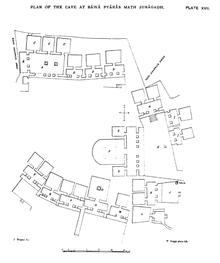Junagadh Buddhist Cave Groups

| Pilgrimage to |
| Buddha's Holy Sites |
|---|
 |
Junagadh Cave Groups are located in Junagadh district of the Indian state of Gujarat. These caves group includes Uparkot Caves, Khapra Kodiya Caves and Baba Pyare Caves. Three separate sites of rooms carved out of stone to be used as monks' quarters. These caves were carved starting from Emperor Ashoka's period up to 1st–4th century AD.
Khapra Kodiya Caves
[edit]The oldest, the Khapara Kodia Caves, on the basis of scribbles and short cursive letters on the wall, are dated to 3rd-4th century BC during the Emperor Ashoka’s rule and are plainest of all cave groups.[1] These caves are also known as Khangar Mahal.[2] They were carved into living rock during the reign of Emperor Ashoka and are considered the earliest monastic settlement in the area. These caves are along the edge of the ancient Sudarshan Lake and little outside Uparkot fort, Northerly. They are carved out in an east–west longitudinal ridge. Caves are small in area. But, it has unique architecture of the water tanks design on western side and L-shaped residence. Caves were used by bhikkus during vassa period. After many years of use, they were abandoned because cracks within that let water seep into living quarters, rendering them unusable. Many accounts say that after this, the monks left for Maharashtra, where they went on to carve many similar and more elaborate structures. Khapara Kodia was damaged by later quarrying, and now only the highest story remains.[3]
Baba Pyare Caves
[edit]

The Bava Pyara Caves are located near Modhimath, little outside Uparkot fort complex, southernly. These are much more intact than the Khapara Kodia caves. The caves were constructed during the Satavahana regime in 1st–2nd century A.D.[1] According to the Xuanzang's travel account they were constructed in 1st century A.D.[2] Northern group has four caves. South eastern group has chaitya and spacious court.[1] Group has 13 caves modelled in three floors, carved in 45 m. (150 ft.) long, influenced by Buddhist architecture.[3] Bava Pyara caves contains artworks of both Buddhism and Jainism.
Buddhistic Caves
[edit]

These caves located at Uperkot beyond the 300 feet deep moat, close to Adi Kadi Vav, were carved in 2nd–3rd century A.D. These caves have influence of Satvahana architecture with combination of Graeco- Scythian style. According to ASI "The cave group is in three tiers, with all members of each galleries shown in semi-relief, but only two storeys having regular floors. The upper floor has a deep tank, covered on three sides with verandahs and Kakshasana on west and north-west side. Lower floor has with corridor and pillars. The lower floor has exquisitely carved pillars whose base, shaft and capital carry unique decorative design."[1] These caves are gilded with beautiful pillars and entrances, water cisterns, horseshoe-shaped chaitya windows, an assembly hall and cell for meditation.[4]
References
[edit]- ^ a b c d "Ticketed Monuments - Gujarat Buddhist Cave Groups, Uperkot, Junagadh". Archaeological Survey of India, Government of India. Archived from the original on 26 September 2013. Retrieved 25 November 2013.
- ^ a b Sagar, Krishna Chandra (1992). Foreign influence on ancient India. New Delhi: Northern Book Centre. p. 150. ISBN 978-8172110284. Retrieved 25 November 2013.
- ^ a b "Buddhist Caves". Gujarat Tourism - Tourism Corporation of Gujarat Limited. Archived from the original on 12 December 2010. Retrieved 25 November 2013.
- ^ "Uparkot". Gujarat Tourism - Tourism Corporation of Gujarat Limited. Archived from the original on 24 June 2016. Retrieved 18 May 2016.
External links
[edit]
- Buddhist caves in Gujarat
- Caves of Gujarat
- Rock-cut architecture of India
- Former populated places in India
- Buddhist pilgrimage sites in India
- Buddhist monasteries in India
- Architecture in India
- Tourist attractions in Junagadh district
- Caves containing pictograms in India
- Monuments of National Importance in Gujarat
